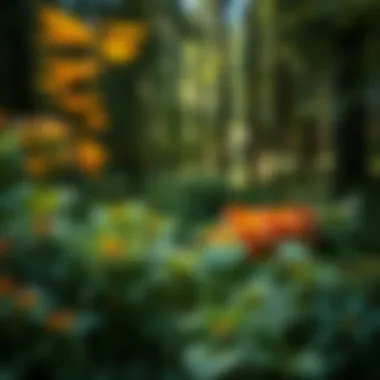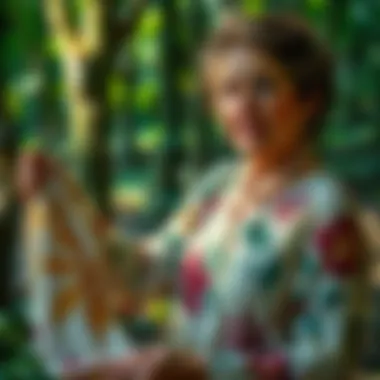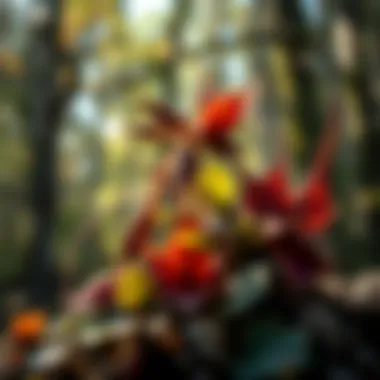Exploring the Art and Impact of Plant Dyed Clothing


Intro
In recent years, there’s been a noticeable shift toward more sustainable practices in the fashion industry. As consumers become increasingly conscious of their environmental impact, many are venturing into the vibrant world of plant dyed clothing. This ancient practice not only revitalizes time-honored textile traditions but also offers a way to reduce humanity’s reliance on synthetic dyes, which can be harmful to both the environment and health.
This article navigates through the fascinating landscape of plant dyes—from how these colors are extracted from natural materials to their implications in modern fashion. We will uncover the historical significance of botanical dyes, explore the sustainability they offer, and contrast their use with synthetic alternatives that often come with a hefty environmental price tag. All the while, we aim to inspire a deeper appreciation for this rich artistry and the critical role it can play in shaping a more eco-friendly textile industry.
Another aspect worth noting is the depth of craftsmanship involved in plant dyeing. Each step, from selecting appropriate flora to the actual dyeing process, requires not just skill but a certain poetic sensitivity to nature. As we draw back the curtain on this vivid craft, we invite you to consider the plethora of colors that nature provides, as well as the stories interwoven within each fabric’s fibers. Let’s dive into the core themes that this article will unravel in the pursuit of old-world elegance fused with modern ecological awareness.
Preface to Plant Dyed Clothes
The world of plant dyed clothes is not just a chapter in the saga of fashion; it is a vibrant narrative steeped in history, culture, and the brilliant hues of nature itself. As environmental concerns rise and the quest for sustainable practices deepens, understanding plant dyes becomes essential. They weave together the threads of artistry and ecological mindfulness, offering a compelling alternative to synthetic counterparts that often come with strings attached.
Plants have been used to create dyes for millennia, showcasing a profound connection between humanity and nature. These dyes are derived from various parts of plants—roots, bark, leaves, and even fruits—each yielding colors that can be subtle or bold. Not only do they provide unique shades, but they also promote sustainable practices by minimizing the environmental impact typically associated with synthetic dyeing processes. Moreover, as consumers become more conscious of their choices, the allure of organic textiles draws both everyday individuals and fashion connoisseurs.
Defining Plant Dyes
Plant dyes, in Layman’s terms, are colorants derived from botanical sources. To pin it down further, these dyes can be categorized into two types: direct dyes and mordant dyes. Direct dyes, as the name suggests, can bond directly with the fabric, while mordant dyes require a binding agent, known as a mordant, to fix the color onto the textile.
In essence, plant dyes can emerge from various sources:
- Roots: Indigo and madder are prime examples, giving depth and richness to fabrics.
- Flowers: The vibrant shades of marigold or coreopsis reflect the spectrum of nature’s palette.
- Leaves: The dyer's sumac can yield soft greens and yellows.
- Barks and Nuts: Walnuts are treasured for their deep, earthy tones.
As this segment of textile production gains traction, recognizing the nuances in the types of plant dyes enhances not just their usage but also the appreciation among artisans, designers, and enthusiasts alike.
The Historical Context of Plant Dyeing
The journey of plant dyeing is as old as civilization itself. Historical records indicate that ancient Egyptians used plant-based dyes for their textiles, while Native Americans mastered the art using local flora long before modern dyeing methods emerged. Notably, indigo was so revered in the Indian subcontinent that it was once known as "blue gold."
Different cultures developed unique techniques and colorways, often imbued with symbolism. For instance:
- The Japanese: Shibori, a technique involving folding and binding fabric, has created stunning patterns, showcasing plant colors that wrap around stories of tradition.
- The Mayans: Created stunning blues from the indigo plant, linking their garments to spirituality.
By exploring these historical perspectives, one uncovers a rich tapestry of uses, traditions, and meanings that plant-dyed textile has held across cultures. It reinforces the practical and artistic significance these materials have enjoyed through centuries, hinting at a future where this ancient technique does not merely survive but thrives in the modern world of fashion.
The Science Behind Plant Dyes
Understanding plant dyes goes beyond mere aesthetics. It's caught up in a dance of chemistry and biology that sets the stage for their vibrant hues. This section dives deep into how colors originate from plant materials, providing insights into the practical and theoretical implications of using these dyes. Knowledge of the science behind plant dyes presents significant benefits, especially for sustainability initiatives in textile production. It helps to demystify the processes involved, enabling practitioners and enthusiasts alike to appreciate the craft and its environmental impact.
Botanical Sources of Color
Plants serve as a veritable cornucopia of colors. When exploring botanical sources, one quickly identifies that not all plants yield the same shades. Some common sources include:
- Plant Roots: Root vegetables like beets and madder provide rich reds and pinks.
- Barks and Wood: The heart of some trees, like oak, can produce deep tans and browns.
- Leaves: Indigo leaves, for example, are known for their deep blue offerings.
- Flowers: Asters and marigolds often render bright yellows and oranges.
Moreover, the chemical compounds found in these parts of the plants often interact with the others in the dyeing process. For instance, flavonoids are responsible for many of the yellow to brown shades, while anthocyanins contribute to reds and blues. Understanding these sources isn’t just an academic exercise; for designers and artisans, it opens a treasure chest of possibilities for achieving desired coloring effects.
Extraction Methods
The journey from plant to cloth begins with extraction, a process that involves collecting and processing plant materials to unlock their color potential. The most common methods of extraction include:
- Simmering: This method involves boiling plant materials to release the dyes, capturing the color in water. It’s a straightforward process but requires careful monitoring to avoid degradation of the color compounds.
- Cold Extraction: Some dyes are sensitive to heat. In this method, materials steep in cold water for much longer, allowing a gentler extraction.
- Fermentation: A more complex interaction occurs during fermentation, where the plant matter breaks down over time, releasing vibrant colors. This technique often yields unexpected results that can vary significantly based on environment and time.
Each extraction method presents unique challenges and opportunities. Experience plays a crucial role in achieving consistent and desired results.
Mordants and Their Role
Mordants are key players in the dyeing process, serving as fixatives that enhance the color uptake of the dye onto textile fibers. Their importance cannot be overstated.
The term "mordant" comes from the Latin word mordere, meaning to bite, which aptly describes how these substances bind dyes to fibers. Common mordants include:
- Alum (Potassium aluminum sulfate): Often used for its effectiveness on many fibers, especially cotton and wool.
- Tannins: Extracted from sources like oak galls, these can serve as mordants by themselves or improve the performance of other mordants.
- Iron and Copper: While they may yield darker shades, they also require careful handling as they can cause undesired effects, such as weakening fibers.


"Mordants not only create a bond between dye and fabric but also can transform colors into something unexpected. By altering the amount and type of mordant, one can achieve a whole spectrum of tones."
Understanding these factors equips artisans and manufacturers alike to adapt their techniques, enhancing both the beauty and longevity of plant-dyed textiles.
Environmental Considerations
The focus on environmental considerations in the realm of plant dyed clothing cannot be overstated. It encapsulates a myriad of elements ranging from sustainability to biodiversity. Given the current climate crisis, understanding the impacts of our fashion choices becomes vital. Plant dyes offer an avenue to pivot away from the traditionally destructive practices of the textile industry toward more eco-conscious methods. This section will delve into the various aspects of plant dyes that contribute to a healthier planet.
Sustainability of Plant Dyes
Plant dyes are inherently more sustainable than their synthetic counterparts. They arise directly from nature, utilizing renewable resources such as leaves, roots, and bark. This directly contrasts with synthetic dyes, produced via petrochemicals that emerge from exhaustible fossil fuels. Furthermore, the cultivation of dye plants can bolster local agriculture, allowing communities to grow crops in harmony with their environment.
Moreover, using plant dyes can significantly reduce water pollution, often caused by synthetic dyes that seep into waterways. For example, using indigo derived from plants like Indigofera tinctoria ensures that growers don't have to rely on harmful chemicals. Interestingly, many plant dyed textiles biodegrade more seamlessly, mitigating the long-term environmental damage associated with synthetic fibers.
Comparison with Synthetic Dyes
It’s essential to draw a line between plant dyes and synthetic dyes to appreciate the former's environmental advantages. Synthetic dyes, while initially offering vibrant palette choices, come with strings attached—quite literally. From water pollution to health risks for workers in factories, the synthetic dye industry carries a heavy burden.
- Water Usage: The process for producing synthetic dyes consumes a tremendous amount of water, adding stress to local water sources. In contrast, many natural plant sources require less water, particularly when grown in their native environments.
- Toxic Byproducts: Synthetic dyes usually lead to toxic byproducts that require extensive treatment processes. Plant dyes, being natural, typically produce safer waste that’s less damaging to land and water.
- Energy Consumption: The energy required to manufacture synthetic dyes is often significantly higher due to the complex chemical processes involved. In contrast, many plant materials can often be extracted with simple methods, reducing energy usage.
The growing movement towards using plant dyes indicates a promising trend in the fashion industry that aligns better with ecological principles.
Impact on Biodiversity
One of the key benefits of utilizing plant dyes is their positive relationship with biodiversity. By promoting the use of diverse native plants for dyeing, the practice encourages the conservation of different species rather than the cultivation of single-crop systems. This enables ecosystems to flourish, and contributes significantly to environmental resilience.
Using native plants not only preserves traditional knowledge around cultivation methods but also reconnects communities with their local environments. There’s a rich tapestry of knowledge embedded in these practices. For example, cultures around the world employ regional plants for coloring textiles, each with its distinct stories and methods. This deep-rooted practice safeguards plant species from extinction and maintains ecological balance.
"The survival of plant species used in dyeing is not just an ethnic issue; it’s crucial for preserving the environment."
In summary, the adoption of plant dyed clothing creates an intricate connection between sustainable practices and environmental health. It aids in fostering agricultural diversity and champions ecological awareness that the fashion industry desperately needs. As this sector evolves, incorporating plant dyes into mainstream usage may prove to be a pivotal step toward embracing a planet-friendly workflow.
Cultural Significance of Plant Dyed Clothing
The cultural significance of plant dyed clothing echoes through ages and across continents. These pieces are not just garments but are threads woven into the fabric of human history, each hue telling a story, a narrative of identity, environment, and belief. Embracing plant dyes goes far beyond the aesthetic; it encapsulates traditions, cultural prisms, and deep-rooted practices that celebrate diversity while bridging generations. In this section, we reflect on how plant dyed clothing embodies the essence of cultural heritage.
Traditions Worldwide
Various cultures around the globe have cultivated their own unique traditions surrounding plant dyeing. For instance, in India, the art of Bandhani or tie-dye involves intricate patterns created through knots, and often combines the use of natural indigo, which has been cherished for millennia. This method is traditionally passed from mother to daughter, ensuring that not only the technique but also the accompanying cultural significance endures.
In Japan, Shibori presents another fascinating example. This process utilizes folding, twisting, and bunching fabric to create shapes and patterns, often dyeing it with indigo for a rich result. Each region possesses specific techniques, colors, and meanings tied deeply to seasonal festivals and spiritual beliefs.
Similarly, in Africa, indigenous communities showcase vibrant textiles dyed from plants like hibiscus and baobab. These garments are integral to ceremonial attire and everyday wear, reflecting social status, tribal identity, and even age. In many West African countries, wearing specific patterns is a visual language, communicating stories and heritage.
Symbols and Meanings
The colors derived from plants carry layered symbolism, often connecting wearers to unseen narratives. For example, in many cultures, a blue garment might symbolize peace or tranquility, while red could evoke strength and courage. The natural sourcing of these dyes adds an element of sustainability that reflects a respect for Mother Nature within cultural contexts.
Among indigenous tribes from the Americas, colors on textiles are frequently linked to the earth's cycles and natural elements. Turmeric, for instance, yields a rich yellow and is associated with fertility and joy, while madder roots produce a deep red, symbolizing life and protection. These meanings not only enhance the visual appeal of the garments but also deepen the connection of the wearer to their ancestry.
"In every thread of dyed fabric lies a story waiting to be unraveled—a testament to the traditions that bind us to the past while urging us towards the future."
The cultural significance of plant dyed clothing captures the attention of increasingly conscious consumers, tying them to a lineage of artistry and sustainability. In the face of globalization, these textiles offer a grounding force, a tangible reflection of identity in a rapidly changing world. Such garments are a celebration of craftsmanship, history, and ecological awareness, reminding us of the value inherent in traditional practices.
Each stitch, each color, and each pattern beckons us to pause and ponder the unity of culture and nature. As we continue to discuss the technological advancements and contemporary applications of plant dyed fabrics, it is essential to remember that at their core, these threads are the embodiment of the human experience.
Contemporary Applications
In the modern textile landscape, the use of plant dyes carries significant weight. As consumers grow more environmentally conscious, the fashion industry is increasingly recognizing the merits of plant-dyed clothing. These innovations not only reflect a commitment to sustainable practices but also cater to the demand for unique, artisanal qualities in garments.
The transition towards plant dyes in contemporary applications provides an opportunity to tap into the rich history of natural dyes while meeting the current consumer trends that favor authenticity and transparency in production. The trend towards sustainability is now shaping the fashion conversation, leading to a variety of applications ranging from high-fashion runways to eclectic artisan markets.


Fashion Industry Trends
The fashion world has been rapidly evolving, and plant dyes are riding the wave of this change. Recently, numerous designers have begun to showcase their collections using natural dyes, claiming not only a palette derived from nature but also a story behind each shade. This is vital, as today's shoppers are keen on products that are not just aesthetically pleasing but also sustainable.
Some key trends include:
- Transparency in sourcing: Brands are now openly sharing the origins of their dyes, which fosters connection with consumers, allowing buyers to feel good about their purchases.
- Collaboration with artisans: Partnerships between brands and local dyers highlight the craftsmanship involved in dyeing, adding layers of authenticity to collections.
- Experimentation with botanical palettes: Designers are extending beyond traditional colors by using a range of plants, creating unique hues that simply can’t be replicated with synthetic alternatives.
These trends signify an important shift in the fashion landscape towards a more thoughtful approach that embraces individuality.
Artisanal Practices
Artisanal practices around plant dyeing are now being celebrated, often accessing time-honored techniques passed down through generations. As markets embrace the whole artisanal mindset, brands are not just selling clothes, but a piece of culture and heritage. The revival of traditional methods brings forth ethical craftsmanship, promoting local economies and the skills of local dyers.
Artisans utilize:
- Indigo, a staple: This plant has become iconic in the dye world, known for its ability to create rich shades of blue. Artisans often employ fermentation techniques that enhance the depth of color.
- Natural resist techniques: Much like ancient batik methods, these practices create patterns and designs through the resist of dyes, resulting in intricate and meaningful attire.
Artisanal dyers hold deep connections to their craft, leading to garments infused with story and significance. This can resonate particularly well with consumers who desire more than just a product but seek the narrative woven into the fabric.
DIY Plant Dyeing Techniques
The popularity of DIY plant dyeing techniques has surged as individuals explore creative outlets that also align with sustainable practices. The hands-on nature of dyeing with plants allows people to connect with their clothing on a deeper level. Here’s how to get started in this intriguing aspect of sustainable textile practices.
Choosing Suitable Plants
Selecting the right plants is crucial for effective dyeing. Specific flora can provide vibrant shades, while others may produce more muted tones. Some popular choices include:
- Avocado pits: Pink to peach hues can be derived from the pits, presenting an excellent example of recycling food waste.
- Turmeric: Known for its bright yellows, turmeric is a readily available spice that yields fantastic results.
- Marigold flowers: Those vivid blooms produce sunny yellow and orange tones, perfect for an eye-catching palette.
These plants offer not only beautiful colors but also relatively straightforward methods of extraction, making them accessible choices for first-timers.
Step-by-Step Instructions
Embarking on a plant dyeing project begins with a commitment to the detailed process involved. Here are the general steps to get you going:
- Prepare your materials: Gather the plant material, fabric, and necessary tools.
- Extract the dye: Boil the plant material in water to draw color out.
- Mordant the fabric: Using a mordant will help the dye bond to the fabric.
- Dye the fabric: Submerge the prepped fabric in the dye solution and simmer.
- Rinse and dry: Once you achieve the desired shade, rinse out the excess dye and dry your fabric.
This hands-on approach fosters a connection between the dyer and the material, resulting in a product that holds deeper value.
Recommended Materials
For successful plant dyeing, certain materials can enhance the experience. Essential items include:
- Natural fibers: Materials like cotton, silk, or wool take plant dyes exceptionally well. Their natural composition allows for better absorption and more intense colors.
- Mordants: Substances like alum, tannin, or iron help fix the dye onto the fabric and can even alter the final color.
- Dye pots: Using stainless steel or glass pots minimizes contamination from metals that can affect the dye's interaction with the fabric.
By equipping yourself with the right materials, you enhance the chances of achieving vibrant and lasting colors, leading to a rewarding DIY experience.
Exploring the world of plant dyes grants not only creative opportunities but also a chance to engage with sustainable practices that reflect a growing desire for ecological responsibility in fashion.
Through these contemporary applications, plant dyeing emerges as an important thread in the fabric of modern textiles, echoing a harmony of culture, sustainability, and creativity.
Challenges and Limitations
The world of plant dyed clothing offers numerous benefits, yet it is not free from hurdles. Understanding the challenges and limitations entails evaluating both the technical aspects and the availability of resources. This consideration impacts not just artisans but also the broader community interested in sustainable fashion. It is essential to appreciate these dynamics to gain a full perspective on the scope and future of plant dyeing techniques.
Color Consistency Issues
One of the paramount challenges in plant dyeing lies in achieving color consistency. Unlike synthetic dyes, which can be manufactured to exact standards, plant dyes vary not only by the species used but also by the conditions under which the plants are grown. The soil's composition, the climate, harvesting time, and even the method of extraction can all affect the hues produced. For example, indigo from a specific region may yield a vibrant blue under optimal conditions but can turn to a grayish shade if environmental factors shift.
Moreover, natural variability also plays a role in this inconsistency. Two batches of dye extracted from the same plant type at different times might produce noticeably different results. This unpredictability can frustrate designers, especially in the fashion industry where uniformity is often key to product lines.


To navigate this, some practitioners employ sampling methods before a full-scale dyeing project. Maintaining detailed records of the dyeing process, including plant sources, weather conditions, and the extraction methods, can help refine the colors over time. However, it's a labor-intensive process that requires both skill and patience.
Availability of Resources
Access to quality resources for plant dyeing can be another significant limitation. Depending on geographical location, the availability of specific dye plants may vary. Many plants used for dyeing, such as woad or madder, are not commonly found everywhere. Each region has its own local flora, limiting the color palette available to dyers who are unwilling or unable to source materials from distant locales.
Additionally, some dye plants may require specific growing conditions that can limit the quantity harvested. This scarcity can drive up the price of natural dyes, making them less accessible to small-scale artisanal producers. Furthermore, the knowledge surrounding effective growing and extraction methods is not widespread, resulting in lost opportunities for many budding dyers.
"As the world shifts toward sustainable practices, the need for local sourcing and knowledge transmission becomes increasingly critical—every shade carries a story worth telling."
In some areas, educational programs focused on sustainable agriculture could help address these issues. Encouraging local cultivation of native dye plants may lead not just to enhanced availability but also to a greater depth of knowledge in dyeing techniques, ultimately creating a more robust and resilient community of plant dyers.
In summary, while plant dyeing presents invaluable ecological benefits and aesthetic variety, recognizing its challenges—especially with color consistency and resource availability—is key. Addressing these issues requires collaborative efforts among eco-conscious designers, local farmers, and educational institutions to create a more sustainable dyeing future.
Future of Plant Dyed Textiles
The future of plant dyed textiles is indeed a stirring topic, carrying substantial weight in conversations about sustainability, fashion, and environmental responsibility. As awareness grows surrounding ecological degradation and the adverse effects of synthetic dyes, the allure of plant-based alternatives is seeing a significant uptick. This dynamism is not just about aesthetic appeal; it encapsulates a broader movement toward a holistic approach in fashion and textile production.
Innovations in Dye Technology
Rapid advancements are unfolding in dye technology that might enrich the palette of plant dyed fabrics. Innovations like bioengineering plants to enhance their dye yield hold promising potential. Scientists are experimenting with gene editing techniques, such as CRISPR, to create plants with more vibrant colors and improved dyeing properties. This could lead to a wider array of hues that can be sourced sustainably.
"The intersection of technology and nature in fabric dyeing is paving new avenues for expression and environmental stewardship."
Moreover, innovative practices in extraction methods are emerging, reducing waste and maximizing the dyeing process. Techniques such as enzyme-assisted extraction are gaining traction. These methods utilize natural enzymes to break down plant materials, yielding a richer color while being less harmful to the environment. Such advancements can potentially increase the efficiency of dye production, making it more economically viable.
Market Growth and Consumer Awareness
As consumers become more conscious about their purchasing decisions, the market for plant dyed fabrics is experiencing notable growth. Brands are increasingly recognizing the demand for transparency in sourcing, resulting in a pronounced shift toward eco-friendly practices. Reports from various industry insights suggest that consumers prioritize brands that promote sustainability, often demanding more information about how products are made.
This growing awareness has led to a flourishing niche market, with artisans and small-scale producers entering the fray. These individuals often incorporate traditional techniques, emphasizing the cultural richness inherent in plant dyeing. Online platforms have also emerged, facilitating the connection between consumers seeking sustainable options and producers of plant dyed garments.
- Social media campaigns highlighting the environmental impact of dyeing textiles offer visibility to the virtues of plant-based options.
- Documentaries and educational resources have sprung up, educating consumers about the traditional as well as innovative practices in plant dyeing.
The rise in market growth correlates with deeper consumer desire for authenticity and connection to their clothing, which is often absent in mass-produced synthetic textiles.
Integrating Plant Dyes in Sustainable Fashion
Plant dyes can serve as a catalyst for the integration of sustainability in fashion. As designers become more attuned to their environmental footprint, the allure of natural dyes is hard to resist. Integrating plant dyes involves not only selecting the right materials but adopting a mindset that prioritizes cycles over disposability.
Some fashion designers are experimenting with culturally resonant themes, fusing modern aesthetics with traditional dyeing methods. This approach not only honors the roots of plant dyeing, but also speaks volumes about heritage and craftsmanship, creating a unique narrative around each piece.
Moreover, collaborations between textile artists and sustainable fashion brands can breed innovation. By fostering an environment of cooperation, there is room for exploration of hybrid approaches that merge technology with nature.
The benefits are evident:
- Enhanced brand loyalty, as consumers increasingly resonate with sustainability.
- Reduction in environmental impact, easing the burden on ecosystems previously strained by harmful industrial practices.
- Revitalization of traditional craftsmanship, encouraging the passing of knowledge to new generations.
In summary, the future of plant dyed textiles shines bright. With ongoing innovations, an expanding market, and a deeper commitment to sustainable fashion, plant dyes stand as a vital piece in the quilt of eco-conscious textile production.
Closure
The discussion surrounding plant dyed clothing is not merely about color; it's an exploration of craftsmanship, sustainability, and cultural heritage. As the world grows ever more environmentally conscious, the relevance of plant dyes in the textile industry continues to expand. The historical roots of plant dyeing remind us that ancient practices hold the key to modern sustainability. This realization prompts both artisans and manufacturers to reconsider their material sources and methods.
Summary of Key Points
- Historical Context: Plant dyeing has been an integral part of various cultures around the globe, often tied to rituals and traditions.
- Environmental Benefits: Unlike synthetic dyes, plant dyes often pose less threat to ecosystems, promoting a sustainable textile industry.
- Artisanal Value: Contemporary artisans are reviving these age-old techniques, creating unique pieces that carry stories and meanings.
- Challenges: While the benefits are clear, issues like color consistency and resource availability remain hurdles that need addressing.
- Consumer Awareness: With increasing interest in sustainable fashion, the market for plant dyed textiles is growing, reflecting a shift towards eco-friendliness.
In summary, the resurgence of interest in plant dyed clothing underscores a collective move towards appreciating not only the aesthetic qualities of textiles but also their environmental and cultural implications.
Call to Action
To those intrigued by the world of textile innovation and sustainability, consider exploring plant dyed garments and the stories behind them. Whether you’re a designer looking for unique textiles or a consumer wishing to make eco-friendlier choices, embracing plant dyes is a step towards sustainability.
Get involved in the community:
- Support Local Artisans: Purchase plant dyed products from local makers to help sustain their craft.
- Learn and Experiment: Try your hand at plant dyeing by following DIY techniques shared on platforms dedicated to textile arts. Engaging in this craft not only connects you to a historical tradition but also promotes environmental consciousness.
- Spread Awareness: Share knowledge about the benefits of plant dyes within your circles and on social media. Educating others can foster a culture of appreciation for sustainable practices in fashion.
Ultimately, the journey through the vibrant hues of plant dyed textiles is one that connects us to nature, culture, and a sustainable future.















